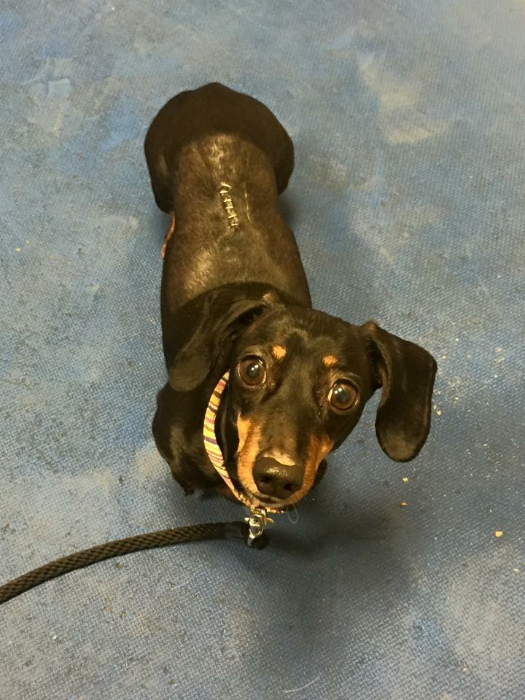Laurie's Blogs.
Jun 2020
Rehab after surgery for canine thoracolumbar disc herniation

In searching through some research articles recently, the following paper caught my eye.
Jeong IS, Piao Z, Rahman MM, Kim S, Kim NS. Canine thoracolumbar intervertebral disk herniation and rehabilitation therapy after surgical decompression: A retrospective study. J Adv Vet Anim Res. 2019;6(3):394‐402.
Objective: Outcomes of surgical decompression for Intervertebral Disc Herniation (IVDH) WITH rehab and WITHOUT rehab.
Materials & Methods: 96 dogs in the rehab group (RG) and 90 dogs were in the non-rehab group (NRG). Rehab included a combination of electrotherapy, infrared therapy, deep tendon reflex, and aquatic treadmill exercise.
Results:
•86.46% (83/96) of dogs had a successful neurologic outcome in the RG group, which was significantly (p < 0.01) higher than the NRG group 52.22% (47/90).
•The success rate differed when the preoperative grading system was considered. The success rates of grades 2, 3, and 4 were 97.14% (34/35), 97.33% (42/45), and 43.75% (7/16), respectively, in the rehabilitated groups, whereas in the non-rehabilitated groups, success rates were 82.35% (28/34), 51.85% (14/27), and 17.24% (5/29), respectively.
•The post-operative times until unassisted standing in the rehabilitated dogs in grades 2, 3, and 4 groups were 4.6 ± 2.8, 5.1 ± 3.6, and 8.0 ± 3.4 days, respectively. The times until unassisted walking in the same group and grades were 6.9 ± 2.2, 7.0 ± 2.5, and 13.0 ± 2.10 days, respectively
•The post-operative times until unassisted standing of the non-rehabilitated dogs with grade 2, 3, and 4 were 4.7 ± 4.8, 5.3 ± 4.4, and 8.9 ± 5.1 days and the times until unassisted walking were 7.0 ± 3.2, 7.9 ± 3.2, and 14.4 ± 3.6 days, respectively
Conclusion: Rehabilitation therapy after surgical decompression of thoracolumbar IVDH improves neurologic functions and increases the success rate, especially when the preoperative pathological condition is severe.
Let’s dive into what they did for rehab.
1.Electrotherapy consisted of a TENS unit with electrodes placed to the quadratus lumborum, quadriceps and cranial tibial muscles of both rear limbs for 30 minutes twice a day.
2.Infrared Therapy was the provided at 800nm – 1200nm for 0 – 15 minutes daily.
3.Standing training: Using slings and balls, for 15 – 20 minutes daily.
4.Balance board training (when able), for 15 – 20 minutes, twice a day.
5.Deep Tendon Reflex stimulation, for 12 – 20 minutes daily
6.Aquatic treadmill (when able), started slow and gradually increased, hip height at first and then lowered.
Hmmm… So, if I wanted to repeat this study or utilize the technique, I simply couldn’t! They used a TENS, but then in their discussion talked about electrical muscle stimulation. Who knows what kind of an ‘infrared therapy’ unit they used. What it LED or Laser? What was the power of the unit? How many Joules were delivered? Standing training and balance training I can visualize. However, I don’t know about any of you, but 15 – 20 minutes of balance board training, twice a day seems like a lot! Then we have Deep Tendon Reflex stimulation. I don’t know what they were doing there. Using a reflex hammer? Tapping on the muscles? Bowen therapy? No clue! Then we have the Underwater treadmill. Fair enough, we do tend to all use it based on the dog’s ability, however since they put average times for the other exercises, I was disappointed that no average times were given.
Then the other holes to poke in this study were -1) Patient selection was based on owner interest and whether or not the client was willing to pay for in clinic rehab. Remember this was a retrospective study. 2) No mention was made regarding how long rehab was provided on average.
So, while I really liked the abstract, the details of this paper left me wanting for more. So… should you be looking for research to validate rehab post-op disc surgery, stick with the abstract on this one!
Here’s the link to the paper: https://www.ncbi.nlm.nih.gov/pmc/articles/PMC6760504/


